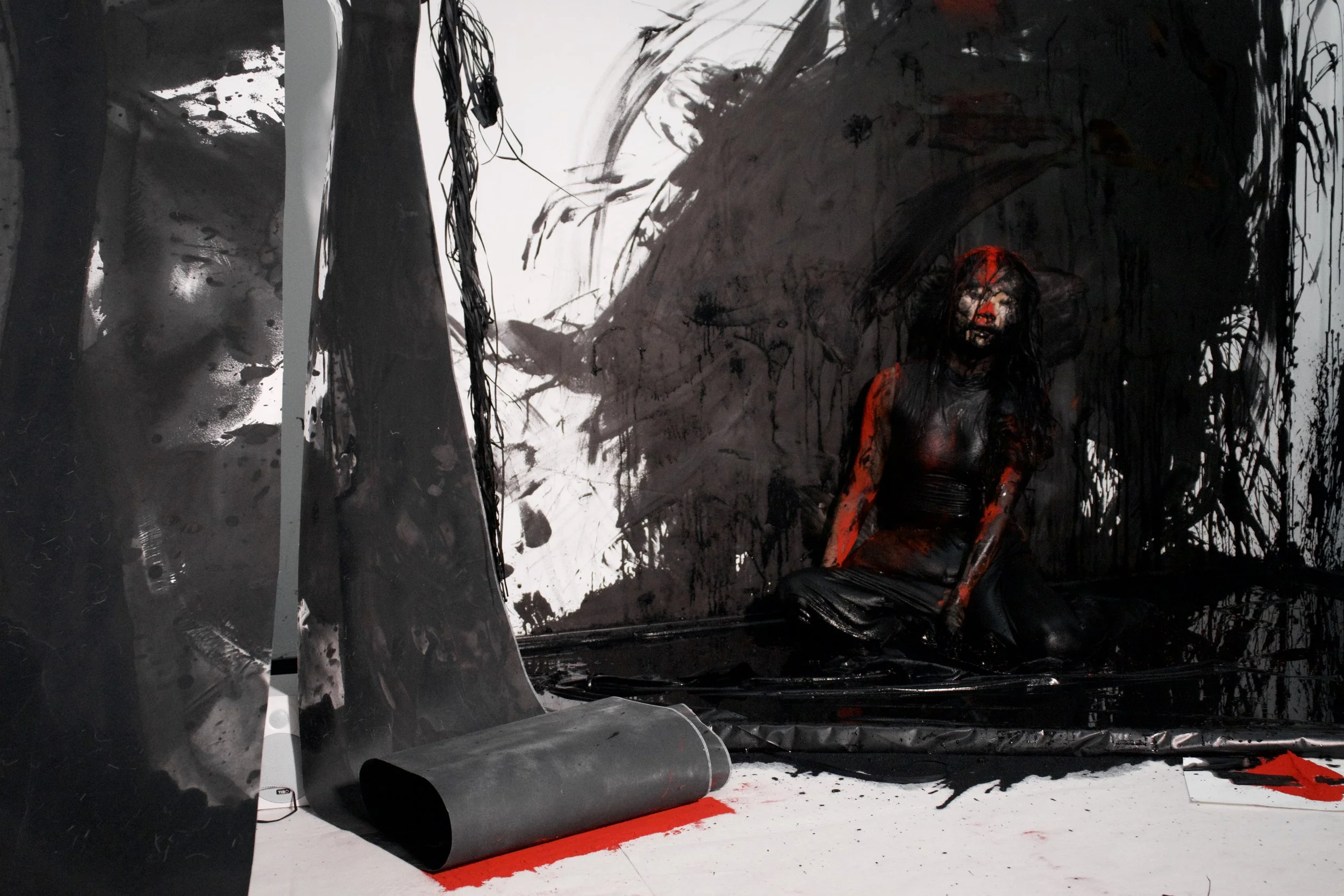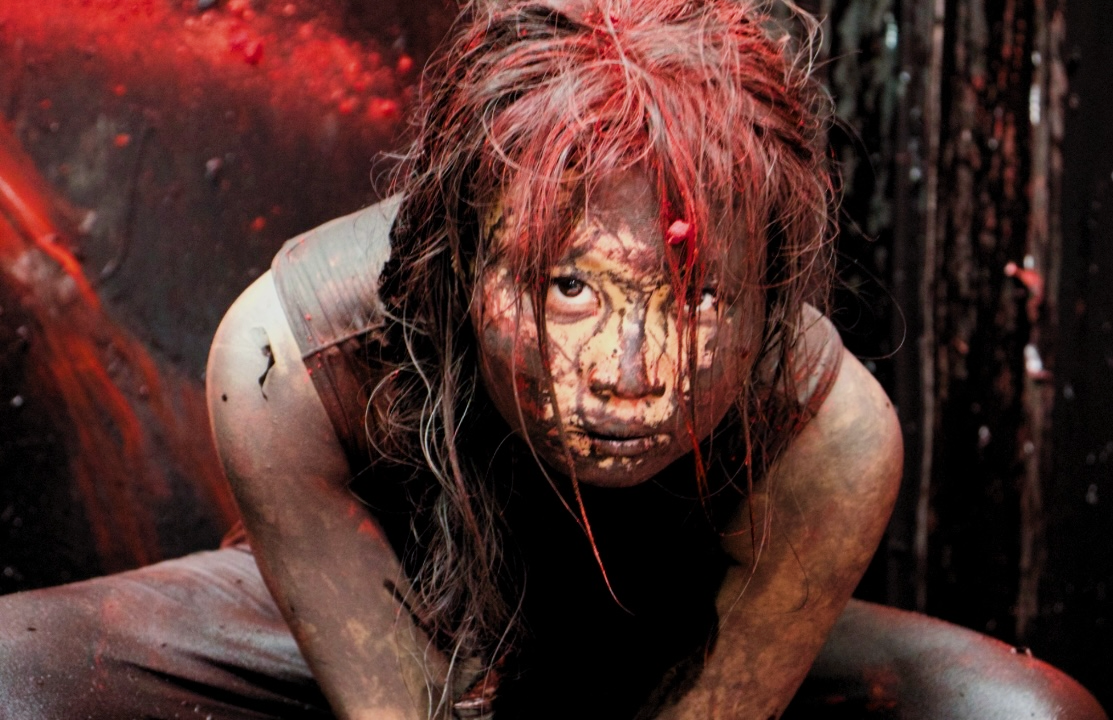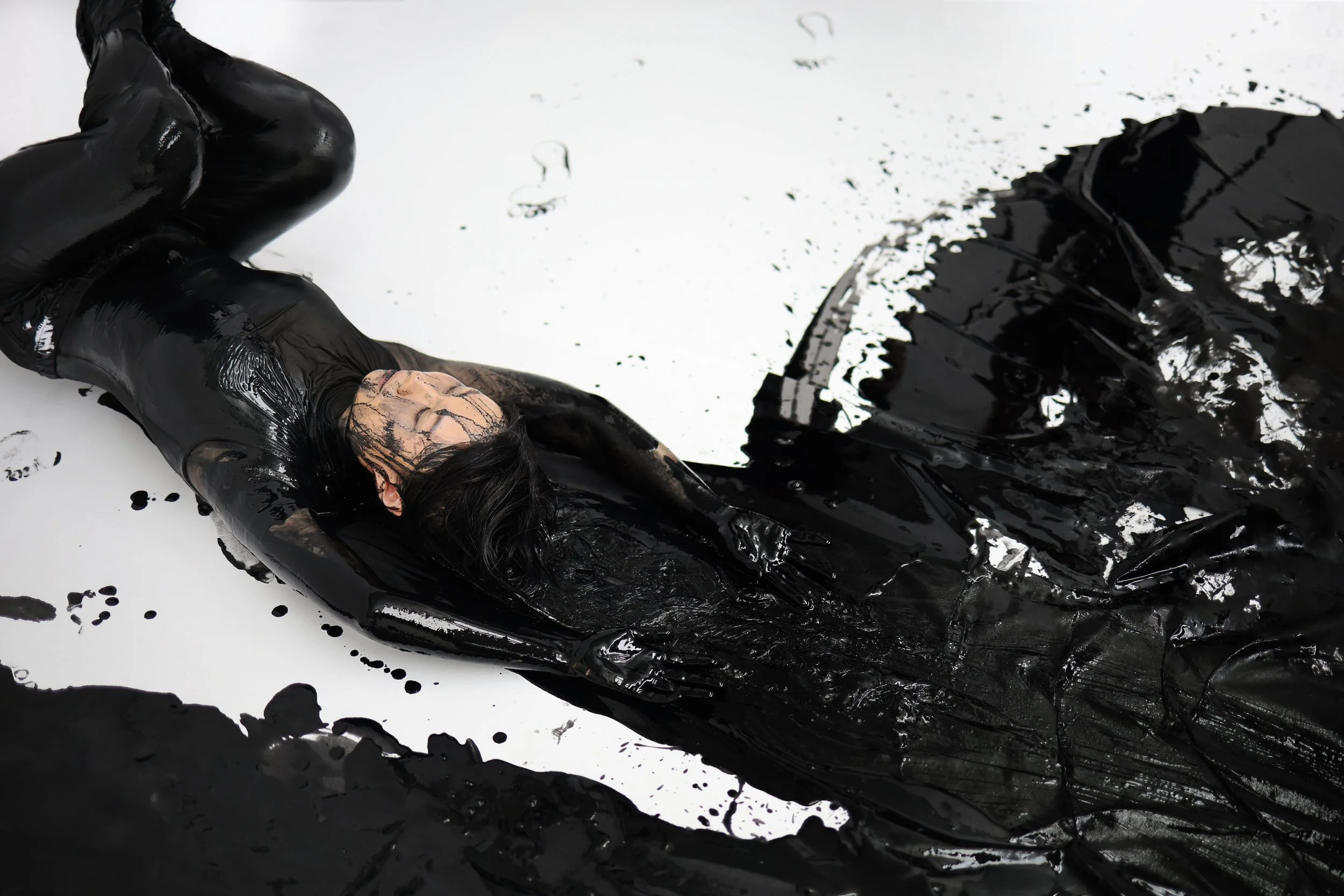Weeds
30 Hour Endurance Art Performance
2000 cm * 150 cm (paper portion),
ink, red paint, body, rice paper,
Royal College of Art, London, SW11 4AY
2024
Within the tides of global migration, I exist in a state of transience—never fully belonging, yet constantly adapting.
The hyper-regulated order of modern cities strips individuals of their agency over space, mirroring the marginality of the migrant experience: when space cannot be altered or truly possessed, the sense of belonging becomes unattainable. In my performance art, I employ acts of “destruction” and “reconstruction” as metaphors for the struggles of cultural nomads. This is both an inquiry into identity and a phenomenological experiment in transient empowerment.
Fingernails scraping against walls, Xuan paper torn and reassembled, ink bleeding uncontrollably into space—these actions simultaneously defy established structures and embody anxieties over the erasure of native cultures. Within the hyper-integrated machinery of civilization, destruction becomes the most honest form of construction. Torn Xuan paper generates new fiber at its fractures, symbolizing the resilience of cultural identity forged through rupture. Ink, even after being erased, leaves traces—affirming that every transient intervention inscribes itself onto space and memory. This five-day performance ultimately transforms the exhibition site into a testament to the migrant experience—an impermanent yet continually rewritten locus of belonging.
在全球化移民浪潮的裹挟下,我始终处于一种“临时状态”——未曾完全归属,却又不断适应。
现代城市的高度秩序剥夺了个体对空间的干预权,映射出移民的边缘化处境:当空间无法被改变或真正掌控,归属感便无从谈起。 在我的行为艺术实践中,我以“破坏”与“重建”作为隐喻,揭示文化游民在寻找归属中的挣扎。这不仅是对身份的探寻,更是一场关于“短暂性赋权”(transient empowerment)的实验。
指甲划破墙面、宣纸撕裂再重组、墨迹在空间中无序扩散——这些行为既是对既定规则的挑战,也承载着对本土文化流失的焦虑。在高度整合的文明体系之内,破坏反而成为最真实的建设。 撕裂的宣纸在断裂处生出新纤维,象征文化身份如何在创伤中生长并强化韧性;被清理后的墨迹依然留下痕迹,揭示任何临时性的介入都将在空间与记忆中留存。这场持续五天的行为表演,使展览空间成为移民经验的见证,一个流动的、不断被书写的临时归属之地。
Prohibition of Spatial Destruction 空间破坏权的剥夺
In modern cities, space is strictly regulated—public areas controlled by policy, private spaces bound by property laws. Within this rigid framework, individuals are stripped of the right to alter or destroy space, a fundamental act of self-assertion. Destruction is not mere negation but a means of engagement—children doodling on walls, architects demolish to create, artists deconstruct to rebuild. For migrants, this prohibition carries deeper existential weight. As perpetual guests, they traverse spaces without true belonging, their expressions confined within permissible limits. Deprived of the ability to shape their surroundings, they experience forced self-restraint, reinforcing a transient state of existence. To build is impossible, to erase is forbidden—they must adapt without leaving a trace. Here, creativity shifts from assertion to negotiation, and destruction, once an act of claiming space, becomes an unspoken impossibility.
在现代城市中,空间受到严格规训——公共区域受政策管控,私人空间受产权制度束缚。在这一高度秩序化的框架下,个体被剥夺了改变或破坏空间的权利,而破坏本身并非单纯的否定,而是一种介入方式——儿童在墙上留下涂鸦,建筑师拆除旧建筑以创造新空间,艺术家解构既定形式以重组新的系统。 对于移民而言,这种剥夺具有更深远的存在主义影响。作为永恒的客人,他们穿行于不同的空间,却难以真正拥有归属感,表达也被迫受限。当无法塑造、改变甚至拆解空间时,个体的自我表达被迫压抑,进一步强化了自身的临时性。建造是不可能的,抹去亦被禁止——他们只能在限定的空间内被动适应,不留下任何痕迹。在这种境遇下,创造力不再是主动的宣言,而是一种妥协;破坏,原本是对空间的主张,如今却成了一种无法言说的不可能。
Performance Environment This work revolves around the Prohibition of Spatial Destruction, questioning how individuals in hyper-regulated spaces resist passive existence and leave traces of their ephemeral presence. The work consists of three key components:
Painting: root. Ink brushstrokes sprawl like wild grass, representing how disciplined individuals seek cracks within constraints to sustain their growth. The repeated tearing and reassembling of rice paper metaphorically embody the cyclical process of cultural fragmentation and restoration.
Ink Pool: Liquid ink flows across the floor, its form continuously reshaped by the footsteps of viewers. This instability reflects the fluidity of migrant identity and the ever-evolving nature of self-perception.
Walls: Scratches, torn paper, and pigment mark the tension between permitted destruction and prohibited alteration. The walls serve both as canvases of memory and as metaphors for power structures.
Throughout the performance, I engage in subtle yet persistent acts of destruction to challenge spatial stability: scratching the walls to record bodily presence, allowing ink to seep beyond predetermined boundaries, and reinforcing torn paper through repair—suggesting the reconstruction of cultural identity. The presence of viewers further activates this dynamic process; their movements extend ink trails, their touch deepens the textures of the walls, and their participation continuously reshapes the work. In a world where spatial destruction is prohibited, individuals are deprived of the right to alter their environment, reinforcing the transient and impermanent nature of identity. Through destruction as intervention, this work ensures that ephemeral gestures leave lasting imprints in both space and memory, transforming the exhibition site into a space of resistance, negotiation, and coexistence.
本作围绕“空间破坏权的剥夺”(Prohibition of Spatial Destruction)展开,探讨个体在高度秩序化的环境中如何抵抗被动接受的状态,并在短暂介入中留下痕迹。作品由三部分构成:
绘画:20米充满墨水的宣纸深深的扎进现场地面中间并和墙面相连,水墨笔触如野草般蔓延,象征被规训的个体在限制中奋力寻求生长扎根。通过连接宣纸和头发,反复撕裂与重组,隐喻文化身份在破碎与自我身份不断重塑。
墨池:随着我将整个身体泡在墨池并不断泼洒,液态墨迹在地面流动,观者的步伐扰动其形态,形成不稳定的动态场域。这种不确定性回应了移民个体在空间中的流动性,亦象征自我认同的不断重塑。
墙壁:指甲划痕、纸张撕裂、颜料渗透等人为介入,刻画空间“被允许的破坏”与“被禁止的改变”之间的张力。墙体既是承载记忆的画布,也是权力关系的隐喻。
在整个表演过程中,我参与了微妙而持续的破坏行为,以挑战空间的稳定性:刮擦墙壁以记录身体的存在,让墨水渗出预定的边界,并通过修复加固撕裂的纸张--暗示文化身份的重建。观众的出现进一步激活了这一动态过程;他们的动作延伸了墨迹,他们的触摸加深了墙壁的纹理,他们的参与不断重塑着作品。 在一个禁止破坏空间的世界里,个人被剥夺了改变自身环境的权利,从而强化了身份的短暂性和无常性。通过将破坏作为干预手段,这件作品确保了短暂的姿态在空间和记忆中留下持久的印记,将展览现场转变为一个抵抗、妥协和共存的空间。
Concept, Direction, Painting, Performance, Scenography & Sound: Lihong Bai
Film & Edit: Sunghoon Song
Performance Assistance: Minghao Sun, Zhu Wang
Photograph: Yang Zou, Jeremy Chih-Hao Chuang, Ning Kang, Yingqi Wang, Ciprian Ivanov
Technical Support: John Strutton, Roddy, Helena De Pulpits, Tao Wen, Zhu Wang, Cayetano Sanz de Santamaría,Charlotte Raymen, Julian Rodriguez Jirau, Jianxia Kang, Jessica, Harry
Resource Provisioning: RCA Battersea Resource Store
Music in the video: Ryuichi Sakamoto & Noto Alva, ‘Coda’
Special Thanks: John Strutton, Andrew Pierre Hart, Whiskey Chow, Xuetin Shao, Ciprian Ivanov, Hannah Dowling, Jan Valik, Ying Chu






